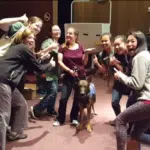Written by Katie Burland Poremba
originally posted June 7, 2016
Dexter was confused. Scared. Alone. Why was he back here? Would this family never come back for him either?
No. They wouldn’t. Dexter had become one of the millions of dogs relinquished to shelters across the country each year. He could have easily been one of the two million dogs to never leave. He was already on strike two, you see, and he was only ten months old.

What was his crime?
Being humongous, young, strong, and silly. That was it. A terminal case of no manners. “Incorrigible,” it was said. Dexter was one of the many silent victims of the R+ movement, which advocates the use of only positive reinforcement in training. He had been turned into the shelter twice, because he was not a dog that responds 100% to R+. Perhaps if he had been taken in hand by a phenomenal R+ trainer with excellent timing and a true talent for training, maybe. Herein lies one of the problems: the average dog owner is not cut out to train a high-drive, incredibly strong, adolescent dog with only R+. These dogs need a little guidance and some boundaries to go along with all that bounce. But because of the prevailing attitudes in most dog training available to the average dog owner, corrections are synonymous to abuse.
The end result is Dexter.
A Weimaraner-Viszla mix that was twice relinquished to a kill shelter, because potential death at the end of a hypodermic needle at ten months of age was considered kinder than a leash correction and the word “no.” Many people will tell you that the notion that R+ can cause things like this to happen is a myth. I am here to tell you I own that myth. He’s drooling on my foot as I type. And he’s my service dog.
For those of you who don’t know, R+ stands for Positive Reinforcement, which is one of four quadrants of operant conditioning, a learning theory that illustrates that by applying or removing stimuli, you can elicit or extinguish behaviors. The other three quadrants are: negative reinforcement (R-), which is when you remove something in order to increase the likelihood of repeated behavior; positive punishment (P+), which is when you add something that decreases the repetition of a behavior; and negative punishment (P-), where you remove something to decrease a behavior. These four quadrants work together. To use one, without the other three, is a bit like hopping around with your hands tied behind your back to get to the grocery store. Sure, you can do it, but it’s not a very efficient way to travel, and it is far more difficult and time consuming than it needs to be.
“But corrections! They’re abuse, right? No. Dogs correct each other, naturally, all the time… Is it not kinder to teach our dog with a harmless correction for attempting to eat a porcupine, chase a horse, or dash into traffic, rather than have the dog experience a far more dangerous natural consequence?”
Here’s the thing about dog training.
Dog training is supposed to involve the human figuring out the drives, motivations, and learning style of a dog, and then putting that all together and communicating with the dog in the language and methodology he, the dog, chooses. That is not how it often ends up working out to be though. All too often, the human uses the exact same strategy for every single dog, and makes no allowance for individuality of the dog. It is a bit like stepping into a classroom in Kansas and proceeding to teach a biology class in French. Sure, maybe the some of the kids know French, but odds are fairly high that most will stare at you with a blank look on their faces.
When some dogs do manage to learn via an inflexible training ideology, it should not be thought of as a glowing endorsement of that ideology, but instead an amazing commentary on the ability of dogs to adapt to a multitude of communication strategies. The flip side is the sad side, because while the successes of an inflexible training ideology are attributed to that training ideology, failures are often prescribed to faults of the dog, or faults of the owner that is trying to execute the training. The shockingly high failure rates of R+ in the community setting lead owners to get discouraged, and dogs end up being the ultimate losers in this situation.
But corrections! They’re abuse, right?
No. Dogs correct each other, naturally, all the time. The environment corrects, whether it is the consequence of attempting to eat a porcupine, or being kicked by a horse, or being hit by a car. The real world is full of natural consequences for behavior. Is it not kinder to teach our dog with a harmless correction for attempting to eat a porcupine, chase a horse, or dash into traffic, rather than have the dog experience a far more dangerous natural consequence? Personally, I think so.
And then you get another Dexter. Sad, scared, confused, and wondering what he did wrong.
To quote Anna Sewell, in the book Black Beauty, a book that quite literally started the humane treatment of animals movement… “It’s a pity, that a good horse should go to the bad, for want of a real good chance.”
Let’s give all our dogs a real good chance, and teach them not by the ideology we think they should like best, but by the method that proves to be the most successful, as evidenced by a happy, healthy, and well-adjusted dog.
The views and opinions expressed in this article are those of the author and do not necessarily reflect the opinion of Growing Up Guide Pup.







